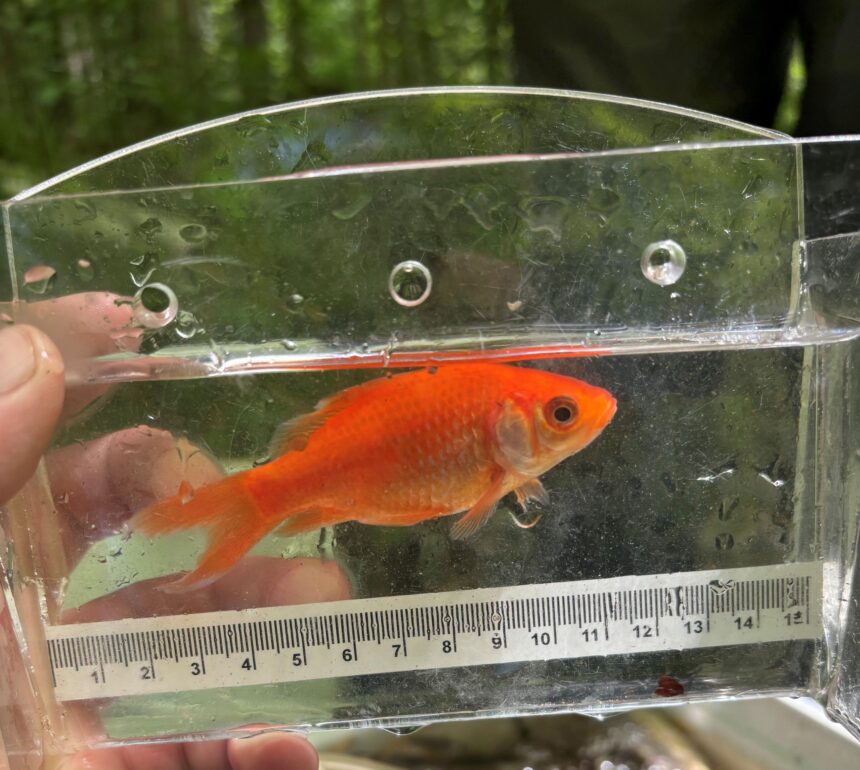This goldfish was caught during electrofishing on a tributary of the Cornwallis River. Like other aquarium fish, goldfish are an invasive species in the wild and pose a risk to native fish stocks. Photo by Jijuktu’kwejk Watershed AllianceArticle contentAn organization looking for signs of salmon parr along tributaries of the Cornwallis River in Kings County says the discovery of a goldfish should be another warning to people to not dispose of aquarium fish in the wild.THIS CONTENT IS RESERVED FOR SUBSCRIBERS ONLY.Subscribe now to access this story and more:Unlimited access to the website and appExclusive access to premium content, newsletters and podcastsFull access to the e-Edition app, an electronic replica of the print edition that you can share, download and comment onEnjoy insights and behind-the-scenes analysis from our award-winning journalistsSupport local journalists and the next generation of journalistsSUBSCRIBE TO UNLOCK MORE ARTICLES.Subscribe or sign in to your account to continue your reading experience.Unlimited access to the website and appExclusive access to premium content, newsletters and podcastsFull access to the e-Edition app, an electronic replica of the print edition that you can share, download and comment onEnjoy insights and behind-the-scenes analysis from our award-winning journalistsSupport local journalists and the next generation of journalistsRegister to unlock more articles.Create an account or sign in to continue your reading experience.Access additional stories every monthShare your thoughts and join the conversation in our commenting communityGet email updates from your favourite authorsSign In or Create an AccountorArticle contentThe Jijuktu’kwejk Watershed Alliance was conducting electrofishing recently and in that process found a goldfish.Article contentArticle contentElectrofishing uses electricity to temporarily confuse or stun fish so they can be netted for scientific research or removal from a waterway.Article contentArticle contentJijuktu’kwejk is the original Mi’kmaw name for what is known more commonly as the Cornwallis River.Article contentFen Boates-Bishop, senior field technician with the alliance, said they were electrofishing in Sharpe Brook in part to determine areas that should have river habitat restoration and remediation. Along with parr they found the bright 11-centimetre-long fish.Article contentIt was in a section of the brook behind Central Kings Rural High School. The invasive fish was taken from the site and given to someone with an aquarium.Article contentBoates-Bishop said the discovery raises concerns when the organization is trying to make the habitat better.Article content“(Goldfish) compete for food and take resources away from native species,” he said.Article contentArticle contentIf caught, they can’t be re-released.Article contentArticle contentIt’s illegal to move live fish – including bait fish – through the province or release them in any watersheds.Article contentThe alliance also found five pickerel in the brook that were about eight inches. Pickerel are also an invasive species and can decimate a native fish population and its food supply, as they easily grow to 70 cm in length.Article contentIsolated goldfish?Article contentBoates-Bishop said he hopes the goldfish was a one-off discovery.Article contentKen Donnelly, the supervisor of the Nova Scotia Invasive Species Council, echoed Boates-Bishop’s concerns. He said the fact the fish was found while electrofishing and there were no others is hopefully a good sign that it was a lone specimen.Article contentThe organization is part of a program called don’t let it loose that tries to educate on the dangers of setting exotic pets and other species free.
Concern as another invasive fish found in Annapolis Valley river












